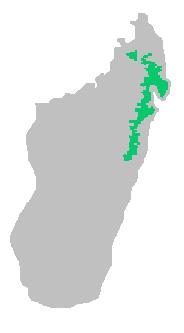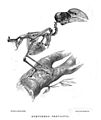Helmet vanga facts for kids
Quick facts for kids Helmet vanga |
|
|---|---|
 |
|
| Conservation status | |
| Scientific classification |
The helmet vanga (Euryceros prevostii) is a really unique bird from the vanga family. It has a striking look with its blue-black body, reddish-brown wings, and a giant, curved blue beak. This special bird lives only in the lowland and lower mountain rainforests of northeastern Madagascar. It mostly eats small creatures like insects. Sadly, the helmet vanga is in danger because its home is disappearing.
Contents
What is a Helmet Vanga?
The helmet vanga is the only bird in its group, called Euryceros. Long ago, scientists thought it was part of the shrike family. But later, they realized it belonged with the other vangas. Scientists believe its closest relative is the rufous vanga. They think these two birds separated about 800,000 years ago. The bird's scientific name, prevostii, honors a French artist named Florent Prévost.
Appearance and Features
The helmet vanga is a large bird, second only to the sickle-billed vanga in size among vangas. It grows to be about 28 to 31 centimeters (11 to 12 inches) long. It weighs between 84 and 114 grams (about 3 to 4 ounces).
Its most amazing feature is its huge, hooked beak. This beak is about 51 millimeters (2 inches) long and 30 millimeters (1.2 inches) deep. The bird's head, neck, chest, and belly are a solid blue-black color. Its wings are a reddish-brown. The tail is long and wide, black underneath and reddish-brown on top. The beak is a bright blue with a black tip. Both male and female helmet vangas look the same.
Where They Live
This bird lives only in the lowland and lower mountain rainforests of northeastern Madagascar. You can find them in places like Marojejy National Park, Makira Natural Park, Masoala National Park, and Mantadia National Park.
What They Eat
Adult helmet vangas mainly eat large insects. However, when they feed their babies in the nest, they might bring other foods. This can include snails, lizards, spiders, and even crabs.
Reproduction and Life Cycle
Helmet vangas usually have one partner for life and breed during certain times of the year. On the Masoala Peninsula, their breeding season is from October to January. Both the male and female work together to build their nest. The nest is shaped like a cup, about 15 centimeters (6 inches) across. They build it from woven plant fibers, moss, and small twigs. The nest is usually placed in a tree fork, about 2 to 4 meters (7 to 13 feet) off the ground. They lay two or three eggs, which are a pinkish-white color.
Dangers and Protection
The helmet vanga is considered to be in danger of extinction. This is mainly because its home, the undisturbed humid rainforest, is being cut down. People are clearing the forests for farming and logging. The number of helmet vangas, which is between 6,000 and 15,000 adult birds, is shrinking. Their forest homes are also becoming separated from each other. Scientists also think that much of their remaining habitat could be lost in the next 50 years due to climate change. Because of these problems, the IUCN has listed the helmet vanga as a vulnerable species.
Gallery






